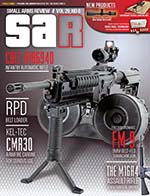Book Reviews: V20N8
By Dean V. Roxby
The M1 Garand 1936 to 1957, 6th Ed.
ISBN-13 978-1-882391-43-1, 223 pages
The US M1 Carbine
ISBN-13 978-1-882391-43-1, 223 pages
These two books are from a large group of books (Currently 17 titles.) that make up the For Collectors Only series, from North Cape Publications.
Primarily dealing with military rifles (One volume does cover the 1911 and 1911A1 pistol), this series delivers a huge amount of technical information in a concise manner.
Each volume details a particular firearm, ranging from just after the Civil War (The .58 and .50 Caliber Rifles and Carbines of the Springfield Armory, 1865-1872), through both World Wars, and post war guns. While US arms are most prominently featured, several foreign rifles are covered as well. The British Enfield series, Russian Mosin-Nagant, Russian SKS-45 series, Swedish Mauser, and Swiss service rifles are also examined in detail.
The two titles reviewed here are The M1 Garand 1936 to 1957, and US M1 Carbines, Wartime Production. The Garand book is written by Joe Poyer and Craig Riesch, while the Carbine book is written by Riesch alone. Both books give very detailed descriptions of exactly which parts are correct for that particular gun. For instance, there were TEN major contractors producing the M1 Carbine between 1942 and 1945. There are many minor variations of parts that may seem insignificant, but are important for the advanced collector. Starting with the basic receiver, the text explains what to watch for between the various manufacturers. Photographs and drawings clearly show these details as well.
Generally speaking, the books are divided into segments covering Receiver Group (including internal parts), Barrel, Trigger Group, Stock, etc. Within these main groups, all the significant parts are dealt with. If a tiny widget was made by two different subcontractors, and marked as such, this information will be found here. Over the course of the production run, numerous small changes were often made to speed production. This is noted as well. Serial number ranges of these change-overs are given also. The authors do note that often bin of new style parts was mixed in a bin of the previous standard, so the change-over may have occurred somewhat gradually.
Various accessories and bayonets are covered also. Wrapping up the books are numerous Appendices. Typical Appendix entries include Assigned Serial Number Blocks, En-bloc Clip markings, Use By Other Countries, etc. Both the Garand and the Carbine book end with a survey page that can be filled out and submitted to the author to assist in further research.
These books measure 5 ½” x 8 ½” each. The Garand book is 270 pages, while the Carbine one is 223 pages. Others in the series are about the same, or more. The Model 1911 Pistol is 560 pages. Black and white photos throughout. The Garand book has four full color plates at the beginning as well. These books contain a great deal of information in a small, concise package, and should be considered for any serious collector.
This article first appeared in Small Arms Review V20N8 (October 2016) |
| SUBSCRIBER COMMENT AREA |
Comments have not been generated for this article.





